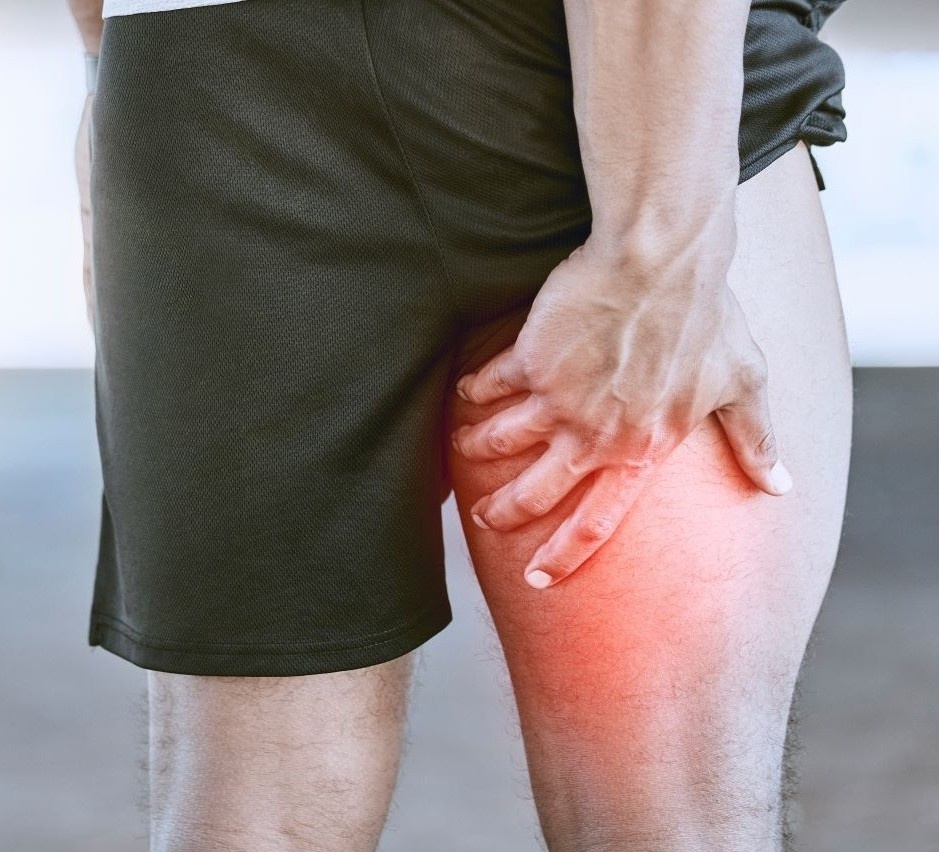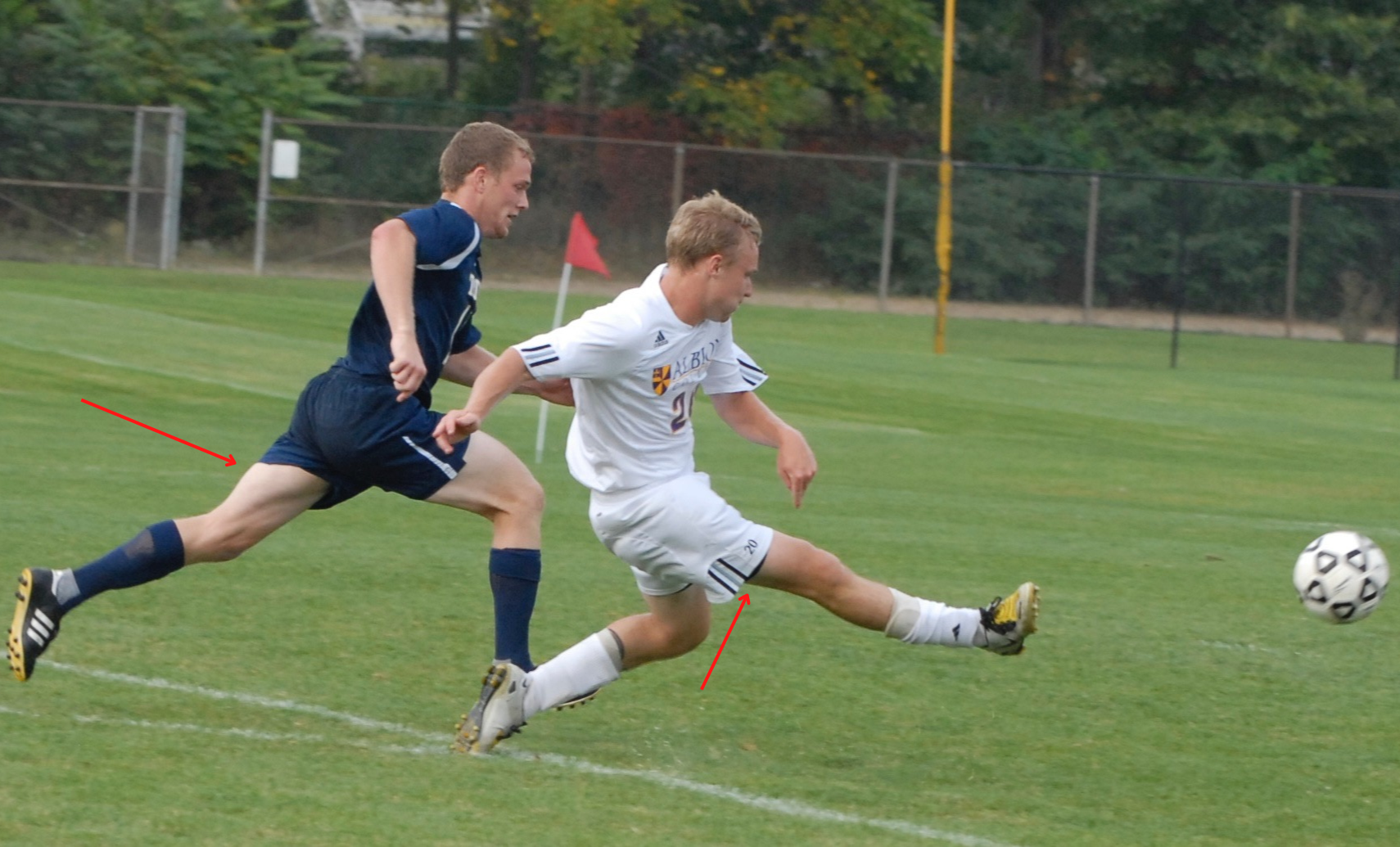Hamstring Injury
Everything you need to know about Soccer Hamstring Injuries
- EDUCATE® -
Understanding Your Hamstring Injury & First Steps to Recovery
In this four-part guide, Dr. Kuhlman shares his knowledge of soccer-specific hamstring injuries, including:
1) Common signs and symptoms of hamstring strains, a grading scale of strain severity,
2) Common mechanisms of injury (MOIs) in soccer
3) When to seek professional help and where to go
4) Basic anatomy of the hamstring muscle group
5) Next Steps... PROTECT® & RECOVER®
1) Do I Have a Hamstring Injury?
How can I tell if I have a hamstring injury? What are the symptoms?
The main signs/symptoms of a hamstring strain are:
- Upon injury, a heard or felt "popping" sensation in the back of the thigh, followed by tenderness, pain, and occasionally bruising
- A tightening or "grabbing" feeling of the muscle
- Recurring pain, especially with movement
- Loss of strength
- In serious cases (especially if the muscle is torn), severe pain and disability

What kind of hamstring strain do I have?
There are three grades of hamstring strain and differentiating between them can help determine the best course of action on how to treat the injury.
- Grade I strains are characterized by pain/tightness in the hamstring muscle, especially with movements such as walking, bending at the waist, and trying to extend the knee. There is not usually a “pop” heard on initial injury and very little, if any, bruising present.
- Grade II is the next step in severity. Sometimes a “pop” is present and there is usually some level of bruising and weakness associated. Movements will be more difficult, and you may have some pain at rest as well.
- Grade III strains are very often accompanied by a “pop/tear” sensation upon injury, complete loss of strength, elevated pain levels, and will almost always have significant bruising in the area.
The above grading scale refers to traumatic or sudden onset of hamstring pain. However, there are cases of hamstring pain that can come on gradually or seemingly without a known reason. While there are several diagnoses that could explain that pain, they are beyond the scope of this guide. If you are having hamstring pain that has come on gradually, I would recommend reaching out to a local Sports Medicine professional.
If your injury is of traumatic nature, continue onto the next sections, which will go what to do in the first week of your injury!

2) Most Common Mechanisms of Injury for Soccer Players
The first is during a sprint, when the player extends their leg forward as they come through their stride . The second is where they are performing a maximal kick, and the hamstring is overwhelmed attempting to control the leg during full knee extension and hip flexion.

3) When to Get Professional Help (and Where to Start)
You are having a hard time moving at all You can’t walk without severe pain You have significant muscle w eakness, a palpable tear, and/or a high level of bruising
“I think I have more than a Grade II hamstring strain, where do I start?”
“I think I have a Grade I or mild Grade II injury, what should I do?”
4) What Are the Hamstrings and What Do They Do?
(Hamstring Anatomy Lesson)
To slow knee extension during a quad contraction (such as during a kick) To control hip flexion (such as during the running cycle)

5) The Next Step...Hamstring PROTECT® Guide:
Framework for what to do right after you injure your hamstring
The first week is arguably the most important week for tissue healing and getting rehabilitation off on the right foot. But what should you do? There is so much information on the internet, it can be like drinking from a firehose.
Luckily, we created an injury treatment guide called PROTECT® - Hamstring Strain, designed specifically for soccer players. This step-by-step, easy-to-follow guide has everything you need to start your rehabilitation journey off right and is divided into four pillars of injury care:
- Pillar 1: Protecting the Damaged Tissue | Rest, Compression, Bracing, Kinesiotaping, Getting Through Your Day Safely
- Pillar 2: Pain Management | To Ice or Not to Ice?, Topical Pain Relievers, NSAID Considerations
- Pillar 3: Tissue Health and Healing | Sleep, Hydration, Nutrition
- Pillar 4: Movement | Massage, Foam Rolling, IASTM
- Putting It All Together: A Sample Day-to-Day Schedule
The PROTECT® - Hamstring Strain Guide was developed thanks to countless hours of research and years of clinical, face-to-face rehabilitation - and it's completely free, you just have to enter your email below!
Get your FREE Guide Here!Ready to Finally Break Your Chronic Hamstring Injury Cycle?
Check out our RECOVER® guide below!

Hamstring RECOVER®
Whether you have an minor hamstring injury, or just want to prevent one, this guide is for you! It consists of three unique phases with hours of expertly crafted content and over 30 hamstring rehab videos to get you back on the pitch!
FORTIFY: Prevent it
Dr. Kuhlman's wide ranging guide dedicated to preventing soccer injuries and enhancing performance using lessons, clinical pearls and techniques refined over 15+ years of working with athletes.
Coming Soon!



